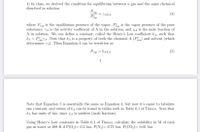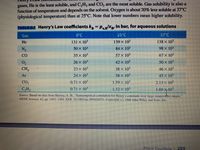
Chemistry
10th Edition
ISBN: 9781305957404
Author: Steven S. Zumdahl, Susan A. Zumdahl, Donald J. DeCoste
Publisher: Cengage Learning
expand_more
expand_more
format_list_bulleted
Question

Transcribed Image Text:4) In class, we derived the condition for equilibrium between a gas and the same chemical
dissolved in solution
Peap
Poop
YAXA
(4)
where Prap is the equilibrium pressure of the vapor, Pp, is the vapor pressure of the pure
substance, 74 is the activity coefficient of A in the solution, and XA is the mole fraction of
A in solution. We can define a constant, called the Henry's Law coefficient ka, such that
kA = PopYA. Note that ka is a property of both the chemical A (Pp) and solvent (which
determines YA). Then Equation 4 can be rewritten as
Poop = KAXA
(5)
1
Note that Equation 5 is essentially the same as Equation 4, but now it's easier to tabulate
one constant, and values of ka can be found in tables such as Table 6.1 of Tinoco. Note that
ka has units of bar, since XA is unitless (mole fraction).
Using Henry's Law constants in Table 6.1 of Tinoco, calculate the solubility in M of each
gas in water at 298 K if P(O2)= 0.2 bar, P(N2)= 0.75 bar, P(CO2)= 0.05 bar.

Transcribed Image Text:He is the least soluble, and C,H, and CO, are the most soluble. Gas solubility is also a
gases,
function of temperature and depends on the solvent. Oxygen is about 20% less soluble at 37°C
(physiological temperature) than at 25°C. Note that lower numbers mean higher solubility.
TABLE 6 Henry's Law coefficients kg = Py.p/xg, in bar, for aqueous solutions
Gas
O°C
25°C
37°C
He
131 x 103
139 X 10
138 X 10
50X 103
84 x 10
98 X 103
CO
35X 10
57 x 103
67x 10
26 X 10
42 x 10
50x 10
0,
CH,
23 X 10
38X 10
46 x 10
Ar
24 x 10
38X 10
45 X 10
CO2
0.71 X 10
1.59X 10
2.13 x 10
CH,
0.71 X 10
1.32 X 10
1.69 X-10
Source: Based on data from Harvey, A. H. "Semiempirical correlation for Henry's constants over large temperature ranges."
AICHE Journal, 42, pp. 1491 1494. DOL 101002/aic.690420531. Copyright (c) 1966 John Wiley and Sons, Inc.
Phase Equilibria205
Expert Solution
This question has been solved!
Explore an expertly crafted, step-by-step solution for a thorough understanding of key concepts.
This is a popular solution
Trending nowThis is a popular solution!
Step by stepSolved in 4 steps

Knowledge Booster
Learn more about
Need a deep-dive on the concept behind this application? Look no further. Learn more about this topic, chemistry and related others by exploring similar questions and additional content below.Similar questions
- ST4D.3 - The vapor pressure of a substance at various mole fractions in a mixture were found to be as follows. Estimate the Henry's law constant [in MPa] for the substance for the particular solvent of this mixture. USE ALGEBRA instead of a graphical approach. Don't forget there's one more data point that isn't listed in the table (the origin). 0.00230.01020.0182 99.7 48.8 |P/КРа 27.7 Type your answer...arrow_forward1-Propanol (P = 20.9 Torr at 25 °C) and 2-propanol (P2 = 45.2 Torr at 25 °C) form ideal solutions in all proportions. %3D Let a1 and x2 represent the mole fractions of 1-propanol and 2-propanol in a liquid mixture, respectively, and y1 and represent the mole fractions of each in the vapor phase. Y2 For a solution of these liquids with a1 0.310, calculate the composition of the vapor phase at 25 °C.arrow_forwardWhat is the vapor pressure of benzene when .75 mol of naphthalene is mixed with 1.00 kg of benzene? The vapor pressure of benzene is 12.6 kPa at 25 degrees Celsius.arrow_forward
- 2. A and B form an ideal solution. At a total pressure of 0.90 bar, Xa(1)=0.65, XA(g) = 0.45. Using this information, calculate the vapor pressures of pure A and pure B.arrow_forwardThe molar mass of liquid A = 85.0 g / mole, that of B = 112.0 g / mole. At 100 C, a solution of mass percentage in A equal to 30.0%, considered ideal, has a vapor pressureof equilibrium equal to 110 kPa. The vapor in equilibrium with this solution has a mole fraction of A equal to 0.450.(a) Determine the mass of A which must be added to 100 g of B to obtain a solution whosenormal boiling point is 100 C. Please give the Answerarrow_forwardA certain dilute solution has an osmotic pressure of 11.1 atm at 25°C. Calculate the difference between the chemical potential of the solvent in the solution and that of pure water. Assume that the density is the same as that of water at 25°C, 0.99705 g-cm-3. (Hint: Express the chemical potential in terms of mole fraction, x1, and rewrite the osmotic pressure equation as OV = n2RT, where n2 is the number of moles of the solute and V = 1.00 L.)arrow_forward
arrow_back_ios
arrow_forward_ios
Recommended textbooks for you
 ChemistryChemistryISBN:9781305957404Author:Steven S. Zumdahl, Susan A. Zumdahl, Donald J. DeCostePublisher:Cengage Learning
ChemistryChemistryISBN:9781305957404Author:Steven S. Zumdahl, Susan A. Zumdahl, Donald J. DeCostePublisher:Cengage Learning ChemistryChemistryISBN:9781259911156Author:Raymond Chang Dr., Jason Overby ProfessorPublisher:McGraw-Hill Education
ChemistryChemistryISBN:9781259911156Author:Raymond Chang Dr., Jason Overby ProfessorPublisher:McGraw-Hill Education Principles of Instrumental AnalysisChemistryISBN:9781305577213Author:Douglas A. Skoog, F. James Holler, Stanley R. CrouchPublisher:Cengage Learning
Principles of Instrumental AnalysisChemistryISBN:9781305577213Author:Douglas A. Skoog, F. James Holler, Stanley R. CrouchPublisher:Cengage Learning Organic ChemistryChemistryISBN:9780078021558Author:Janice Gorzynski Smith Dr.Publisher:McGraw-Hill Education
Organic ChemistryChemistryISBN:9780078021558Author:Janice Gorzynski Smith Dr.Publisher:McGraw-Hill Education Chemistry: Principles and ReactionsChemistryISBN:9781305079373Author:William L. Masterton, Cecile N. HurleyPublisher:Cengage Learning
Chemistry: Principles and ReactionsChemistryISBN:9781305079373Author:William L. Masterton, Cecile N. HurleyPublisher:Cengage Learning Elementary Principles of Chemical Processes, Bind...ChemistryISBN:9781118431221Author:Richard M. Felder, Ronald W. Rousseau, Lisa G. BullardPublisher:WILEY
Elementary Principles of Chemical Processes, Bind...ChemistryISBN:9781118431221Author:Richard M. Felder, Ronald W. Rousseau, Lisa G. BullardPublisher:WILEY

Chemistry
Chemistry
ISBN:9781305957404
Author:Steven S. Zumdahl, Susan A. Zumdahl, Donald J. DeCoste
Publisher:Cengage Learning

Chemistry
Chemistry
ISBN:9781259911156
Author:Raymond Chang Dr., Jason Overby Professor
Publisher:McGraw-Hill Education

Principles of Instrumental Analysis
Chemistry
ISBN:9781305577213
Author:Douglas A. Skoog, F. James Holler, Stanley R. Crouch
Publisher:Cengage Learning

Organic Chemistry
Chemistry
ISBN:9780078021558
Author:Janice Gorzynski Smith Dr.
Publisher:McGraw-Hill Education

Chemistry: Principles and Reactions
Chemistry
ISBN:9781305079373
Author:William L. Masterton, Cecile N. Hurley
Publisher:Cengage Learning

Elementary Principles of Chemical Processes, Bind...
Chemistry
ISBN:9781118431221
Author:Richard M. Felder, Ronald W. Rousseau, Lisa G. Bullard
Publisher:WILEY